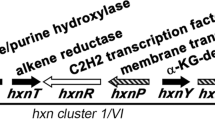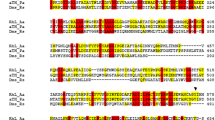Abstract
faoA, the gene of the dye-linked NAD(P)-independent quinone-containing formaldehyde dehydrogenase of methylamine-grown Hyphomicrobium zavarzinii strain ZV 580 was sequenced and analyzed together with an apparent promoter region and adjoining genes in a 7.2-kb fragment of hyphomicrobial DNA. The formaldehyde dehydrogenase, identified as a periplasmic enzyme by its signal sequence, is distantly related to the soluble pyrroloquinoline-quinone-dependent glucose dehydrogenase of Acinetobacter calcoaceticus and to other predicted glucose dehydrogenase sequences. The promoter region, containing about 400 nucleotides upstream of faoA, comprised potential binding sites identical or highly similar to known consensus sequences of the sigma factors σ70 (housekeeping), σH (heat shock), σF (flagellar) and σN (nitrogen). The complex regulation of the transcription of faoA, which is suggested by this setting and emphasized by a possible heat-shock promoter, supports a hypothesis proposing an auxiliary role of the enzyme in lowering detrimental elevated concentrations of formaldehyde, which might arise in the course of stress or regulatory transitions disturbing balanced C1 metabolism.



Similar content being viewed by others
Abbreviations
- Ac-sGDH:
-
Soluble glucose dehydrogenase from Acinetobacter calcoaceticus
- FalDH:
-
Dye-linked formaldehyde dehydrogenase
- GDH:
-
Glucose dehydrogenase
- H4MPT:
-
Tetrahydromethanopterin
- PQQ:
-
Pyrroloquinoline quinone
References
Aboul-ela F, Koh D, Tinoco I Jr (1985) Base–base mismatches. Thermodynamics of double helix formation for dCA3XA3G + dCT3YT3 G (X,Y = A,C,G,T). Nucleic Acids Res 13:4811–4824
Anthony C (1982) The biochemistry of methylotrophs. Academic, London
Attwood MM (1990) Formaldehyde dehydrogenases from methylotrophs. Methods Enzymol 188:314–324
Attwood MM, Quayle JR (1984) Formaldehyde as a central intermediary metabolite of methylotrophic metabolism. In: Crawford RL, Hanson RS (eds) Microbial growth on C1 compounds. ASM, Washington, pp 315–323
Bamforth CW, O’Connor ML (1979) The isolation of pleiotrophic mutants of Pseudomonas aminovorans deficient in the ability to grow on methylamine and an examination of their enzymic constitution. J Gen Microbiol 110:143–149
Barrios H, Valderrama B, Morett E (1999) Compilation and analysis of σ54-dependent promoter sequences. Nucleic Acids Res 27:4305–4313
Blattner FR, Plunkett G III, Bloch CA, Perna NT, Burland V, Riley M, Collado-Vides J, Glasner JD, Rode CK, Mayhew GF, Gregor J, Davis NW, Kirkpatrick HA, Goeden MA, Rose DJ, Mau B, Shao Y (1997) The complete genome sequence of Escherichia coli K-12. Science 277:1453–1474
Boulton CA, Large PJ (1977) Synthesis of certain assimilatory and dissimilatory enzymes during bacterial adaptation to growth on trimethylamine. J Gen Microbiol 101:151–156
Chilcott GS, Hughes KT (2000) Coupling of flagellar gene expression to flagellar assembly in Salmonella enterica serovar typhimurium and Escherichia coli. Microbiol Mol Biol Rev 64:694–708
Chistoserdova L, Vorholt JA, Thauer RK, Lidstrom ME (1998) C1 transfer enzymes and coenzymes linking methylotrophic bacteria and methanogenic archaea. Science 281:99–102
Cleton-Jansen AM, Goosen N, Vink K, van de Putte P (1989) Cloning, characterization and DNA sequencing of the gene encoding the Mr 50 000 quinoprotein glucose dehydrogenase from Acinetobacter calcoaceticus. Mol Gen Genet 217:430–436
D’Aquila RT, Bechtel LJ, Videler JA, Eron JJ, Gorczyca P, Kaplan JC (1991) Maximizing sensitivity and specificity of PCR by pre-amplification heating. Nucleic Acids Res 19:3749
Edman P, Begg G (1967) A protein sequenator. Eur J Biochem 1:80–91
Ford S, Page MD, Anthony C (1985) The role of a methanol dehydrogenase modifier protein and aldehyde dehydrogenase in the growth of Pseudomonas AM 1 on 1,2-propanediol. J Gen Microbiol 131:2173–2182
Garnier J, Osguthorpe DJ, Robson B (1978) Analysis of the accuracy and implications of simple methods for predicting the secondary structure of globular proteins. J Mol Biol 120:97–120
Goenrich M, Bursy J, Hübner E, Linder D, Schwartz AC, Vorholt JA (2002) Purification and characterization of the methylene tetrahydromethanopterin dehydrogenase MtdB and the methylene tetrahydrofolate dehydrogenase FolD from Hyphomicrobium zavarzinii ZV 580. Arch Microbiol 177:299–303
Harborne JB (1995) Ökologische Biochemie. Eine Einführung. Spektrum Akademischer, Heidelberg
Johnson PA, Quayle JR (1964) Microbial growth on C1 compounds. 6. Oxidation of methanol, formaldehyde and formate by methanol-grown Pseudomonas AM1. Biochem J 93:281–290
Kaneko T, Sato S, Kotani H, Tanaka A, Asamizu E, Nakamura Y, Miyajima N, Hirosawa M, Sugiura M, Sasamoto S, Kimura T, Hosouchi T, Matsuno A, Muraki A, Nakazaki N, Naruo K, Okumura S, Shimpo S, Takeuchi C, Wada T, Watanabe A, Yamada M, Yasuda M, Tabata S (1996) Sequence analysis of the genome of the unicellular cyanobacterium Synechocystis sp. strain PCC6803. II. Sequence determination of the entire genome and assignment of potential protein-coding regions. DNA Res 3:109–136
Kato N, Yamagami T, Shimao M, Sakazawa C (1986) Formaldehyde dismutase, a novel NAD-binding oxidorductase from Pseudomonas putida F 61. Eur J Biochem 156:59–64
Klein CR, Kesseler FP, Perrei C, Frank J, Duine JA, Schwartz AC (1994) A novel dye-linked formaldehyde dehydrogenase with some properties indicating the presence of a protein-bound redox-active quinone cofactor. Biochem J 301:289–295
Köhler J, Schwartz AC (1982) Oxidation of aromatic aldehydes and aliphatic secondary alcohols by Hyphomicrobium spp. Can J Microbiol 28:65–72
Köhler J, Kesseler FP, Schwartz AC (1985) Aldehyde oxidation and electron transport in the methylotrophic Hyphomicrobium ZV580. In: Schäfer G (ed) Third European bioenergetics conference. ICSU short reports, vol 3. Cambridge University, Cambridge, pp 220–221
Laufer K, Lidstrom ME (1993) Regulation and expression of bacterial quinoproteins. In: Davidson VL (ed) Principles and applications of quinoproteins. Dekker, New York, pp 193–222
Marison IW, Attwood MM (1980) Partial purification and characterization of a dye-linked formaldehyde dehydrogenase from Hyphomicrobium X. J Gen Microbiol 117:305–313
Oubrie A, Rozeboom HJ, Kalk KH, Duine JA, Dijkstra BW (1999a) The 1.7 Å crystal structure of the apo form of the soluble quinoprotein glucose dehydrogenase from Acinetobacter calcoaceticus reveals a novel internal conserved sequence repeat. J Mol Biol 289:319–333
Oubrie A, Rozeboom HJ, Kalk KH, Olsthoorn AJJ, Duine JA, Dijkstra BW (1999b) Structure and mechanism of soluble quinoprotein glucose dehydrogenase. EMBO J 18:5187–5194
Pearson WR, Lipman DJ (1988) Improved tools for biological sequence comparison. Proc Natl Acad Sci USA 85:2444–2448
Poels PA, Duine JA (1989) NAD-linked, GSH- and factor-independent aldehyde dehydrogenase of the methylotrophic bacterium, Hyphomicrobium X. Arch Biochem Biophys 271:240–245
Sambrook J, Fritsch EF, Maniatis T (1987) Molecular cloning: a laboratory manual, 2nd edn. Cold Spring Harbor Laboratory, Cold Spring Harbor
Sanger F, Nicklen S, Coulson AR (1977) DNA sequencing with chain termination inhibitors. Proc Natl Acad Sci USA 74:5463–5467
Siebert PD, Chenchik A, Kellogg DE, Lukyanov KA, Lukyanov SA (1995) An improved PCR method for walking in uncloned genomic DNA. Nucleic Acids Res 23:1087–1088
Smoker JA, Barnum SR (1988) Rapid small-scale DNA isolation from filamentous cyanobacteria. FEMS Microbiol Lett 56:119–122
Storz G, Hengge-Aronis R (2000) Bacterial stress responses. ASM, Washington
Stover CK, Pham XQ, Erwin AL, Mizoguchi SD, Warrener P, Hickey MJ, Brinkman FSL, Hufnagle WO, Kowalik DJ, Lagrou M, Garber RL, Goltry L, Tolentino E, Westbrock-Wadman S, Yuan Y, Brody LL, Coulter SN, Folger KR, Kas A, Larbig K, Lim R, Smith K, Spencer D, Wong GK-S, Wu Z, Paulsen IT, Reizer J, Saier MH, Hancock REW, Lory S, Olson MV (2000) Complete genome sequence of Pseudomonas aeruginosa PAO1, an opportunistic pathogen. Nature 406:959–964
Tanaka Y, Yoshida T, Watanabe K, Izumi Y, Mitsunaga T (1997) Cloning and analysis of methanol oxidation genes in the methylotroph Hyphomicrobium methylovorum GM2. FEMS Microbiol Lett 154:397–401
Thompson JD, Higgins DG, Gibson TJ (1994) Clustal W: improving the sensitivity of progressive multiple sequence alignment through sequence weighting, position-specific gap penalties and weight matrix choice. Nucleic Acids Res 22:4673–4680
Totty NF, Waterfield MD, Hsuan JJ (1993) Accelerated high-sensitivity microsequencing of proteins and peptides using a miniature reaction cartridge. Protein Sci 1:1215–1224
Von Heijne G (1985) Signal sequences. The limits of variation. J Mol Biol 184:99–105
Vorholt JA (2002) Cofactor-dependent pathways of formaldehyde oxidation in methylotrophic bacteria. Arch Microbiol 178:239–249
Vorholt JA, Chistoserdova L, Stolyar SM, Thauer RK, Lidstrom ME (1999) Distribution of tetrahydromethanopterin-dependent enzymes in methylotrophic bacteria and phylogeny of methenyl tetrahydromethanopterin cyclohydrolases. J Bacteriol 181:5750–5757
Vorholt JA, Marx CJ, Lidstrom ME, Thauer RK (2000) Novel formaldehyde-activating enzyme in Methylobacterium extorquens AM1 required for growth on methanol. J Bacteriol 182:6645–6650
Weaver CA, Lidstrom ME (1985) Methanol dissimilation in Xanthobacter H4-14: activities, induction and comparison to Pseudomonas AM1 and Paracoccus denitrificans. J Gen Microbiol 131:2183–2197
Weaver CA, Lidstrom ME (1987) Isolation, complementation and partial characterization of mutants of the methanol autotroph Xanthobacter H4-14 defective in methanol dissimilation. J Gen Microbiol 133:1721–1731
Yura T, Nagai H, Mori H (1993) Regulation of the heat-shock response in bacteria. Annu Rev Microbiol 47:321–350
Zahn JA, Bergmann DJ, Boyd JM, Kunz RC, DiSpirito AA (2001) Membrane-associated quinoprotein formaldehyde dehydrogenase from Methylococcus capsulatus Bath. J Bacteriol 183:6832–6840
Acknowledgements
The expert technical assistance of Mrs Dagmar Wenzel in maintaining a functional lab is gratefully acknowledged by A.C.S. This work was supported by Deutsche Forschungsgemeinschaft (grants Schw 163/9-1 and Me 765/8-1).
Author information
Authors and Affiliations
Corresponding author
Additional information
This paper is dedicated to Prof. Dr H. G. Schlegel on the occasion of his 80th birthday.
Rights and permissions
About this article
Cite this article
Schwartz, A.C., Gockel, G., Groß, J. et al. Relations and functions of dye-linked formaldehyde dehydrogenase from Hyphomicrobium zavarzinii revealed by sequence determination and analysis. Arch Microbiol 182, 458–466 (2004). https://doi.org/10.1007/s00203-004-0730-0
Received:
Revised:
Accepted:
Published:
Issue Date:
DOI: https://doi.org/10.1007/s00203-004-0730-0




